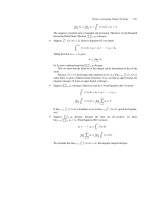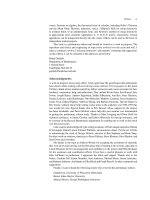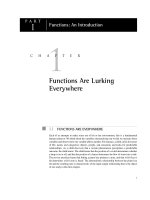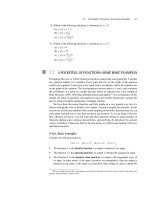An approach to control and dispatch street lighting systems with new dimming method for led-eye sets
Bạn đang xem bản rút gọn của tài liệu. Xem và tải ngay bản đầy đủ của tài liệu tại đây (549.48 KB, 7 trang )
TNU Journal of Science and Technology
226(07): 42 - 48
AN APPROACH TO CONTROL AND DISPATCH STREET LIGHTING SYSTEMS
WITH NEW DIMMING METHOD FOR LED-EYE SETS
Le Tien Phong*, Ngo Duc Minh
TNU - University of Technology
ARTICLE INFO
Received: 09/02/2022
Revised: 19/4/2022
Published: 21/4/2022
KEYWORDS
Artificial intelligence
Dimmer
Dimming
Renewable energy
Street lighting system
Smart lighting zone
ABSTRACT
This paper presents a new approach to street lighting systems using
LED lamp sets, called LED-eye sets. A new dimming method is
proposed to regulate lamp sets having some LED eyes that helps to
lengthen their life time and lighting stability. This paper also proposes
some more solutions to design and operate LED-eye sets basing on
dimming method such as using hybrid power supplies, artificial
intelligence and smart lighting zone to create intelligent lighting areas.
They will help to reduce power consumption from electric grid,
ensure a comfort illumination and decrease the effect of artificial
lighting to the environment. The proposed dimming solution is
verified by an experimental model which uses lamp sets having three
LED eyes for each set. Moreover, the haar cascade classifier is used to
identify vehicle density in this study that helps to decide on/off
control signal for each LED eye. These proposed solutions can be
applied to regulate all LED-eye sets and make lighting systems
become more intelligent and greener.
MỘT CÁCH TIẾP CẬN ĐỂ ĐIỀU KHIỂN VÀ VẬN HÀNH HỆ THỐNG
CHIẾU SÁNG ĐƯỜNG VỚI PHƯƠNG PHÁP LÀM MỜ MỚI
CHO CÁC BỘ ĐÈN CĨ NHIỀU MẮT LED
Lê Tiên Phong*, Ngơ Đức Minh
Trường Đại học Kỹ thuật Công nghiệp - ĐH Thái Ngun
THƠNG TIN BÀI BÁO
TĨM TẮT
Ngày nhận bài: 09/02/2022
Bài báo này trình bày một cách tiếp cận mới với hệ thống chiếu sáng
đường sử dụng bộ đèn LED. Một giải pháp làm mờ mới được đề xuất
với bộ đèn có vài mắt LED giúp nâng cao tuổi thọ và độ ổn định cho
bộ đèn. Dựa trên đề xuất mới, bài báo thiết lập một số giải pháp thiết
kế và vận hành bộ đèn LED như kết hợp nguồn lai, trí tuệ nhân tạo,
smart zone để tăng tính thơng minh cho hệ thống chiếu sáng trong
một khu vực. Những giải pháp này giúp hạn chế lượng điện năng tiêu
thụ từ lưới điện, đảm bảo tiện nghi chiếu sáng và giảm ảnh hưởng
của ánh sáng nhân tạo tới môi trường. Giải pháp làm mờ mới đã được
kiểm chứng thông qua một mô hình thực nghiệm có các bộ đèn có 3
mắt LED, mỗi mắt có cơng suất 50W. Đồng thời, phương pháp haar
cascade được mô phỏng để nhận diện phương tiện giao thơng, từ đó
gửi tín hiệu điều khiển đóng/cắt từng mắt LED. Tập hợp các giải
pháp đề xuất có thể được áp dụng cho tất cả các bộ đèn, giúp hệ
thống chiếu sáng trở nên thông minh, xanh và tiết kiệm năng lượng.
Ngày hồn thiện: 19/4/2022
Ngày đăng: 21/4/2022
TỪ KHĨA
Trí tuệ nhân tạo
Bộ làm mờ
Làm mờ
Năng lượng tái tạo
Hệ thống chiếu sáng đường
Khu vực chiếu sáng thông minh
DOI: />
*
Corresponding author. Email:
42
Email:
TNU Journal of Science and Technology
226(07): 42 - 48
1. Introduction
Lighting systems provide artificial illumination for human activities. It has been developed
and applied many techniques to meet many requirements. Their purpose is to limit the effect of
human to the environment on earth while still ensuring comfort lighting. They can be dimming,
renewable energy, internet of things (IoT), etc. to reduce power consumption from the electric
grid and make more intelligent for whole systems [1]-[3].
Dimming is a good solution to decrease power consumption and reduce light output of lamp
sets. Dimmers has been developed for traditional lamps (such as metal halide) and LED lamps
[4], [5]. For LED lamps, dimmers often use pulse width modulation controller to regulate the
current through LEDs but they affect to color light due to changing wave length of light, decrease
the efficacy of lamp sets and require high technique [6]. Recently, a new prototype of LED lamp
sets has been designed basing on using some LED eyes on each set, called LED-eye set. It is the
main object to study in this paper and must be had a new dimming method without intervening in
rated parameters (current/voltage).
Intelligent lighting has been become the goal of many researches in the world recently. It
means that LED-eye sets must be adapt to the change of vehicle density or environment to
improve comfort illumination and reduce power consumption [7]. The intelligence can be created
by combining many different technologies such as sensors, internet, artificial intelligence (AI)
and communication [1]-[3], [8]. It can help LED-eye sets talk to others and have flexible
response to different requirements if it has a suitable a dimming technology.
To meet above problems, this paper will propose a new dimming solution applied to LED-eye
sets. It will be represented in the next section when combined with other solutions such as hybrid
power supplies, AI and smart lighting zone. The last section will show some conclusions about
achieved issues.
2. New dimming solution for LED-eye sets
LED-eye sets often have (2÷5) LED eyes, where each LED eye has (50÷70)W-rated power
and power is supplied by an individual driver. However, three LED eyes (rated power for each
LED eye is 50W) are the most suitable number for LED-eye sets because their light output is
similar to 250W-metal halide lamp sets, very popular sets in traditional lighting systems [8].
A new dimming solution is proposed for LED-eye sets based on switching on/off each LED
eye as requirements to reduce power consumption and light output. The advantages of this
solution are: not intervening to rated parameters (voltage and current) of each LED eye, ensuring
rated life time and color light output of whole LED-eye set as designed by manufacturers. Fig. 1
describes an example using a LED-eye set with three drivers (D1, D2, D3) for three LED eyes.
Fig. 1. Proposed dimming solution for LED-eye sets
This solution establishes three dimming levels that are 33.3%, 66.7% and 100%
(corresponding to 33.3%, 66.7% and 100% power consumption levels). With three levels, light
output is fully proportional to power consumption and the efficacy is always constant that makes
a difference between proposed dimming and traditional solutions [4]. The light output and energy
consumption will be compared between a 150W-LED lamp set and a 250W-metal halide lamp set
43
Email:
TNU Journal of Science and Technology
226(07): 42 - 48
Light out put (%)
100
LED lamp
(Efficacy is always constant)
80
Efficacy is not constant
(Metal Halide Lamp)
60
40
20
0
100
90
80
70
60
50
40
Energy consumption (%)
in cases of dimming and not dimming. Compared results are represented in Fig. 2 for a normal
operating day corresponding to high, medium and low levels of vehicle density: 100% power
consumption from 6 pm to 10 pm; 66.7% power consumption from 10 pm to 12 pm; 33.3%
power consumption from 0 am to 5 am.
100
2750Wh
80
Metal Halide Lamp
1650Wh
60
850Wh
40
1750Wh
20
30
0
100
Input power consumption (%)
No dimming
dimming
Operating method
a)
b)
Fig. 2. Compared results between LED-eye and metal halide lamp sets
Results in Fig. 2 shows light output from a metal halide lamp set is smaller than a LED-eye
set at 66.7% and 33.3% input power consumption (the smaller power consumption is, the larger
difference of light output is). Compared to metal halide lamp sets, energy consumption of a LEDeye sets in considered range time only equals 60% in case of not dimming and 48.6% in case of
dimming. It means that the proposed solution helps LED-eye sets overcome the light degradation
and consume electric power much smaller than traditional lamp sets.
An experimental model using three LED-eye sets was designed in Thai Nguyen University of
Technology (TNUT), Vietnam to verify the proposed dimming solution. Experimental results are
depicted in Fig. 3.
Fig. 3. Experimental dimming results
Results in Fig. 3 show the capability to individually switch LED eyes on/off and color light
out does not change all dimming time as required. Because it reduces the working time of LED
eyes, the proposed dimming solution also help to increase life time for LED-eye sets in whole
operating cycle. It makes high energy and light efficiency as desired.
3. Street lighting approach with new dimming solution
3.1. Hybrid power sources
Power of each LED-eye posts can be supplied from hybrid power sources that are electric grid
and renewable generations (wind and photovoltaic) in the half-isolated structure [8]. Only in case
of being lack of power from renewable sources (and energy storage), the grid source is
automatically mobilized to supply power to lighting posts. A photovoltaic panel and a wind
turbine (with power converters) are implemented on each lighting post. Almost amount power
from solar irradiance and wind is absorbed to charge to energy storage at daytime. Almost
required power of a LED-eye set is supplied by energy storage and apart by wind turbine in
night-time [8]. The combination of the proposed dimming and renewable generations is
44
Email:
TNU Journal of Science and Technology
226(07): 42 - 48
represented in Fig. 4. It brings high stability for LED-eye sets and helps to reduce large amount
power mobilized from the grid.
a. Not working
b. 1 LED eye is on
c. 2 LED eyes are on
d. 3 LED eye is on
Fig. 4. Working modes for the combination of proposed dimming and renewable solutions
At a lighting post using a LED-eye set, the most suitable values for rated power are (200÷300)
W for the photovoltaic panel and 200 W for the wind turbine. Because power converters become
cheaper and more reliable, the hybrid structure can be easy to implement and design its control
management system.
To have half-isolated structure for power circuit in a LED-eye post, it must be desiged a
automatic switcher and its control signal is calculated by using collected information about
instantaneous capacity, available capacity in next time range to have stability, minimum capacity
to maintain the ability to work in long time of energy storage. The operation of power circuit is
depicted by the algorithm in Fig. 5.
Start
Implement photovoltaic and wind generations, power
converters, energy storage and control management system
Daytime?
Yes
No
Night-time
Charge power from
photovoltaic and wind
generations to energy storage
Check instantaneous capacity of energy storage
No
Instantaneous capacity
> minimum capacity
Yes
Choose power supply from
electric grid
Choose power supply from
renewable sources
Charge power from wind
generation to energy storage
Charge energy wind
generation to energy storage
Yes
Yes
Continue
Instantaneous capacity > minimum
capacity+available capacity
No
No
Stop
Fig. 5. Operation of power circuit at a LED-eye post
3.2. Integration of AI
45
Email:
TNU Journal of Science and Technology
226(07): 42 - 48
Switching LED eyes on/off at fixed time ranges can not be suitable for real requirements,
locations and different time. Due to the development of AI as haar cascade classifier [9], levels of
vehicle density in streets can be identified automatically by using a camera and a small computer
at each a lighting post or a group of lighting posts as described in Fig. 6a (with the structure of
hybrid sources). Using haar cascade classifier, simulation results are represented in Fig. 6b, Fig.
6c, and Fig. 6d. The number of vehicles is analyzed to three level (high, medium, and low) and
switched LED eyes on/off. The number of switched LED eyes is always displayed on the screen
corresponding to the required lighting level such as 3 LED On, 2 LED On or 1 LED On.
a. Hardware
b. 3 LED on
c. 2 LED on
d. 1 LED on
Fig. 6. Simulation results with haar cascade classifier at LED-eyes posts with the participation of hybrid
sources
The cabinet at each LED-eye post can be used some popular controllers such as Programmable
Logic Controller, Arduino Controller, Jetson family computer, Raspberry Pi computer,... The haar
cascade classifier is the best AI technique to identify the number of vehicle in this system because it
can be run by above controllers with low cost and easy to execute. High or low levels of GPIOs
(general purpose input output) or digital gates on above controllers will be decided by vehicle
density and the balance of working time for all LED eyes. The intervention of AI to the work of
LED eyes is represented by the algorithm in Fig.7. It brings an adaptive operating solution to switch
LED eyes on/off automatically corresponding to the current traffic state.
Start
Implement camera and computer at the control cabinet of the LED-eyes post
Manual operation?
No
Automatic operation
Yes
Labors switch on/off circuit
breakers in the control cabinet
Realtime synchronization from ethernet
Yes
Night-time?
No
Activate haar cascade classifier
Analyze the number of vehicle and working time of each LED eye
Decide high/low level for GPIOs or digital gates to switch LED eyes
Calulate total working time of each LED eye
Change control
signal for GPIOs
or digital gates
Balance working time
of LED eyes
Save working time of each LED eye
Yes
Continue
No
Stop
Fig. 7. Integration of AI to the work of LED eyes
46
Email:
TNU Journal of Science and Technology
226(07): 42 - 48
3.3. Smart lighting zone
Smart lighting zone is a part or whole area managed by a lighting supply company. It makes
intelligent capability and reduces cost for labors to operate systems. Lighting in smart lighting
zone is executed automatically based on data analysis about natural light, vehicle density and the
variation of weather conditions. Due to being operating in a distributed structure, it makes the
difference between a smart lighting zone and a traditional lighting zone. Dispatchers will
intervene to the smart lighting zone only when receiving special commands from the national
power system due to not ensuring power supply or unnormal operating conditions [8]. The
structure of a smart lighting zone is shown in Fig. 8.
Light
sensor
Traffic
camera
Control cabinets (manual
or automatic operation)
A LEDeye post
or a
group
Supervisory/
dispatch center
Control
interface on
computer
Control
interface on
smartphone
Dispatchers
Fig. 8. Structure of a smart lighting zone
In Fig. 8, light sensor closes signal circuit when the power of natural light is smaller than
allowable value in night-time. It must be noted that night-time changes corresponding to each
zone because it depends on weather condition very much. An example for night-time of lighting
zone in Vietnam is from 5 pm on this day to 6 am on the next day.
The intervention of AI can change the way to operate groups of LED-eye posts. The
information about vehicle density received from the camera and the computer at this LED-eye
post can be used to regulate next others. It means that AI in a smart lighting zone can help to
create inheritable phenomenon for a series of LED-eye posts as represented in Fig. 9.
Fig. 9. Inheritable phenomenon for a series of lamp posts in smart zone
Lighting demands at different areas are also different due to the variation of weather
conditions. Sensors can be combined with AI at some LED-eye posts to have information about
the decrease of natural light and help them talk to others [8]. All LED eyes in a smart lighting
zone can be controlled to balance total working time that ensure the equalization of life time for
each LED eye. It must be connected to ethernet to synchronize data in whole system. Keeping
pace with intelligent trends for all fields, smart lighting zone will bring many benefits for
managers and the environment to lengthen lives on the earth.
4. Conclusion
This paper proposed a new dimming solution for lamp sets having some LED eyes based on
switching on/off each LED eye. The purpose of this solution is to reduce power consumption and
light output of each LED-eye set at times that does not need artificial lighting much, lengthen life
47
Email:
TNU Journal of Science and Technology
226(07): 42 - 48
time. It aslo makes high stability for whole LED-eye sets that don't affect much to comfort
illumination. Experimental results executed in TNUT showed the accuracy of above feasibilities
and the high ability to implement in real lighting systems. The proposed solution can be used to
design modern and simple dimmers for lamp sets having some LED eyes to replace traditional
dimmers.
Basing on the new dimming solution, this paper also proposes to apply other hardware and
software solutions to limit power consumption from electric grid and enhance the intelligence for
whole lighting system. They are hybrid power sources (combining with renewable energy and
energy storage), camera and small computer with the intervention of AI at LED-eye posts to
identify vehicle density and the topology of smart lighting zone. These solutions can help electric
grid at each LED-eye post work as an half-isolated power supply structure and switch on/off each
LED eyes automatically. Simulation results in this paper shows that the participation of AI (haar
cascade classifier) can help to analyze vehicle density and decide the working modes of all LED
eyes in each lamp set or group of each lamp sets without requiring high speed computer.
Combining with technologies of IoT, all LED-eye posts can talk to others to create a smart
lighting zone that switch on/off LED eyes automatically corresponding to the speed of vehicle to
increase comfort illumination.
This paper created a new approach with some solutions to design dimmers for LED lamps and
dispatch real lighting systems. These solutions help to solve the problem of power shortage,
reduce pressure of using fossil fuels or destroying environment to build new power plants and
reduce the effect of artificial light to creature. They must be continued to study more deeply and
applied other technologies in the 4.0 revolution to improve the intelligence and meet
requirements of energy efficiency and comfort illumination for human's activities.
TÀI LIỆU THAM KHẢO/REFERENCES
[1] P. Primiceri and P. Visconti, “Solar-Powered LED-Based Lighting Facilities: An overview on Recent
Technologies and embedded IoT Devices to Obtain Wireless Control, Energy Savings and Quick
Maintenance,” ARPN Journal of Engineering and Applied Sciences, vol. 12, no. 1, pp. 140-150, 2017.
[2] E. Mathews, S. S. Guclu, Q. Liu, T. Ozcelebi, and J. J. Lukkien, “The Internet of Lights: An Open
Reference Architecture and Implementation for Intelligent Solid State Lighting Systems,” Energies,
vol. 10, 2017, doi: 10.3390/en10081187.
[3] S. Telang and S. Terdal, “An Internet of Things Based Real Time Traffic Light Control to Reduce
Vehicles CO2 Emissions,” International Research Journal of Engineering and Technology (IRJET), eISSN: 2395 -0056, p-ISSN: 2395-0072, vol. 3, no. 7, pp. 713-717, 2016.
[4] Y. Ji and R. Wolsey, "Dimming Systems for High-Intensity Discharge Lamps," Lighting Answers, vol.
1, no. 4, 1994.
[5] I. Kiyak, “A Study on the Working Performance of Dimming Methods for Single and Multichip Power
LEDs,” International Journal of Photoenergy, vol. 2012, 2012, doi: 10.1155/2012/513768.
[6] Y. Pei, S. Zhu, H. Yang, L. Zhao, X. Yi, J. Wang, and J. Li, “LED Modulation Characteristics in a
Visible-Light Communication System,” Optics and Photonics Journal, vol. 3, pp. 139-142, 2013.
[7] J. T. Kim and T. Hwang, "Feasibility Study on LED Street Lighting with Smart Dimming Systems in
Wooi Stream, Seoul," Journal of Asian Architecture and Building Engineering, vol. 15, no. 2, pp. 425430, 2017.
[8] T. P. Le and T. T. T. Nguyen, "Street Lighting Design Solutions in the Efficient Lighting Program,"
International Journal of Research and Scientific Innovation (IJRSI), vol. 4, no. 3, pp. 51-56, 2019.
[9] E. Baser and Y. Altun, "Detection and Classification of Vehicles in Traffic by Using Haar Cascade
Classifier," Proceedings of 58th ISERD International Conference, Prague, Czech Republic, 2016, pp.
19-22.
48
Email:









